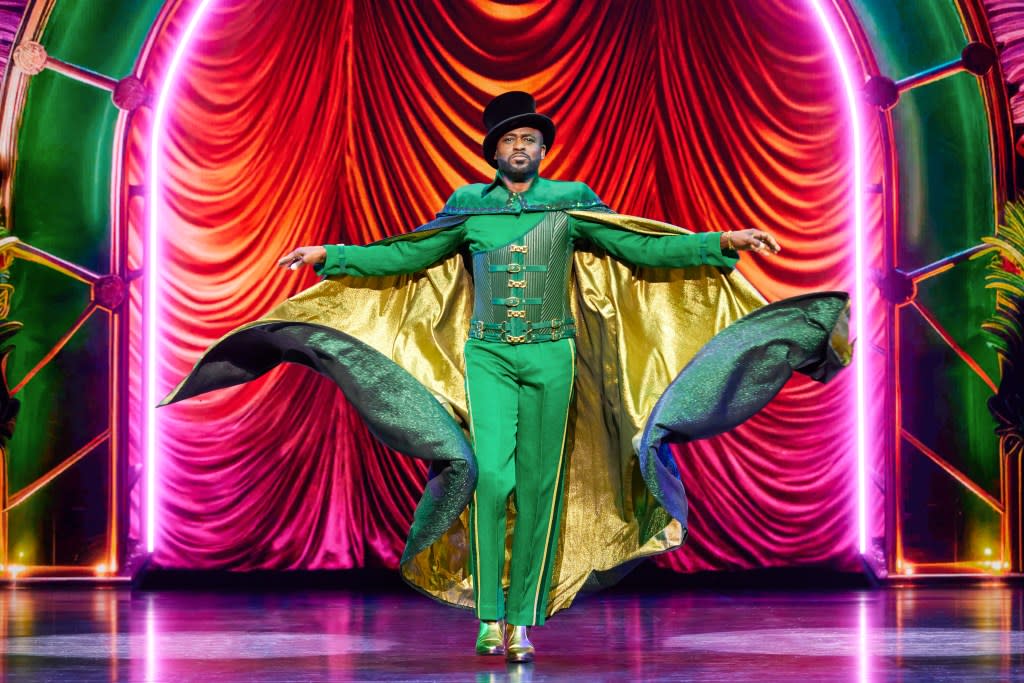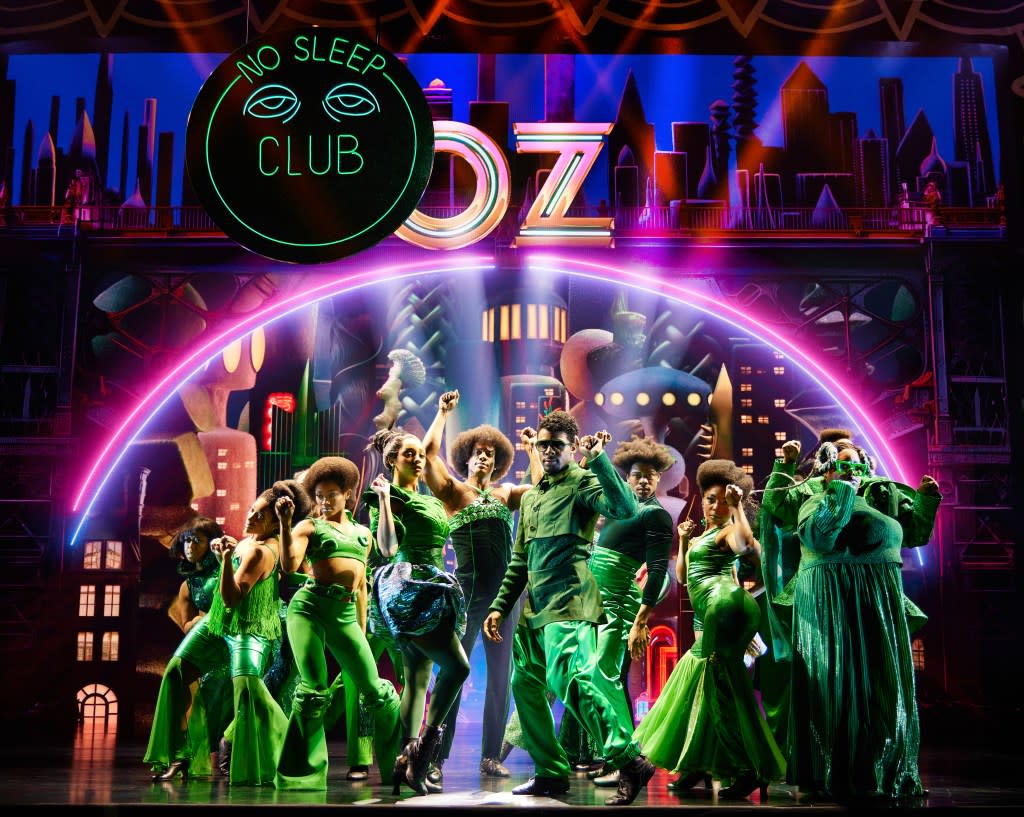‘The Wiz’ is back on Broadway! Come for the nostalgia, fall for the new
Director Schele Williams talks about breathing new, “unapologetically Black” life into Broadway classic “The Wiz.”
I promise: You will not miss Toto. Broadway’s outstanding new revival of “The Wiz,” in the words of its director Schele Williams, “feels like we’re giving you a hug.” A treasured story of Black Americana since the 1978 film version starring Diana Ross and Michael Jackson, itself inspired by the 1975 Broadway smash starring Stephanie Mills and directed by Geoffrey Holder, the theater version of “The Wiz” turns the L. Frank Baum children’s classic “The Wonderful Wizard of Oz” (and its cherished 1939 movie adaptation) into an Afrofuturist fantasia that transcends generations in its lessons about self-assurance, facing fears, and taking risks. Starring Wayne Brady (as the Wizard), Deborah Cox (as “Good Witch” Glinda), and powerhouse newcomer Nichelle Lewis as Dorothy, this newest adaptation electrifies.
“The Wiz’s” top-notch creative team — including Oscar-winning production designer Hannah Beachler (of both “Black Panther” films), choreographer JaQuel Knight (famed for Beyoncé’s “Single Ladies (Put a Ring on It)” visual) and costume designer Sharen Davis (“Ray,” “Dreamgirls”), among others — implies a wizard-like ringleader behind it all, and that leader is theater director Schele Williams.
Director of Broadway’s “The Notebook” and former associate director of “Motown: The Musical,” Williams saw the original run of “The Wiz” at the age of 7. TheGrio spoke to her by phone from Long Island, on the verge of a well-deserved vacation, discussing the Blackity-Blackness of her vision for “The Wiz,” the challenges of remixing all the story’s previous versions and more.
Give us the full account of how you took on directorial duties on this reimagining of “The Wiz.”
I got a call in August of 2020 with an offer to direct the show. I was surprised, ’cause I didn’t even know that there was a [new] version of “The Wiz” that was comin’ around. It was really the most incredible call I ever had. The first thing that I said when I spoke with the producers was, “I need a few months,” because I really wanted to do my due diligence: to read the books [and] review the material. I was like, “Please send me every version of the scripts that you can get your hands on,” [and] really poured through a documentary about L. Frank Baum. Y’know, all the things.
Then I came back with a lot of notecards; a lot of things I moved around where I felt like, here are moments where I wanted to know more; here are songs I think serve this moment in this new place; this is what I’m craving from “The Wiz” in this moment, and this is the overall message I feel could be important for this generation — which is a little different than the message I think we needed in the ’70s. I came back with those things and said, “Here’s the direction I’m interested in taking this story,” and they were all on board.
Aside from standards like “He’s the Wiz,” “Ease on Down the Road” and “Home,” even new music, like the song “Poppies,” pop. Are there plans for a soundtrack?
Oh, there is, yes. We’re recording it at the end of April. I know that they’re trying to get it out as quickly as possible.

Were there any concerns about making the show too Black for white audiences?
There were no concerns. It was a mandate. I was like, “This show is going to be unapologetically Black.”
What was your rule of thumb for remixing previous versions of “The Wiz” and “The Wizard of Oz”?
There were conversations with all the creatives. It was just about where was the best moment to nod to whatever piece of IP we wanted to nod to and what felt like: “This is an organic place to do that.” Really, there was no roadmap to begin with. But as we began, it was like, “Wow, this would be a great moment to put the book in; this would serve this moment best.”
We did know it was really important to me to create a few touchstones for whatever version of this story you knew and loved. We wanted to validate that. Your entry point into “The Wiz” could have been the book; it could have been “The Wizard of Oz”; it could have been “The Wiz” the Broadway show; it could be “The Wiz” the movie. We wanted to say, “We love all those versions, and we love your memories of those versions, and we wanna honor that. We also wanna take you on this journey, and we hope you can embrace and love this too.”
My favorite scene was their entrée into the No Sleep Club of Emerald City — all the forms of dance, from “Soul Train” vibes to Afrobeat and club music.
It was so funny because in the movie [during the Emerald City sequence], it’s obviously “I wouldn’t be caught dead [in] red,” right? They did it with colors and fashion. We had to do the fashion. But we’re not a movie. You can’t snap your fingers, and all of a sudden, everything [goes] red, everything [goes] blue. There’s a magic that can happen in cinema. We have different kinds of magic in [the] theater. One of the questions we were having [was]: “We wanna do this nod to the movie in this moment. How do we do it?” Then JaQuel [Knight] was like, “We do it in dance. We do three different kinds of dance.” It’s with dance and with music. We switch up. Instead of going from red to gold to green, we do three different kinds of dance styles. That’s our nod to the movie in our own way.

Narratively, why connect the Lion, Scarecrow, Tin Man and Dorothy to Evillene in a way that makes them want to overthrow her?
This story came into my world in 2020, which was a tough time having a lot of conversations with a lot of folks about Black existence. And I’ve been having these conversations; it’s what made me want to become a director. Are we elevating our stories, telling them with dignity and representing on stage the responsibility that we have as storytellers? Because what we portray Black folks as onstage leads into our streets. If we’re continuing to reinforce stereotypes, we’re not helping the lives of Black people on the other side of the theater.
What I thought about the Lion, the Tin Man and the Scarecrow, these were all people who came into Dorothy’s life and their backstories were about what happened to them — but did not include that people loved them, that they belonged to someone, that they were entrenched in community and that they were loved. I was like, “I’m not gonna put a Black person onstage without reinforcing these ideas.”
The curses that happened to them were things that they could overcome, and what they were getting back to was, for the Scarecrow, a career that he worked for and loved; the Lion, his family; and the Tin Man, his family that he loved so deeply and missed him. It is not a coincidence that those themes of excellence, care, legacy and belonging are weaved throughout this show.
What’s the significance of the 227 and 701 on the addresses when Dorothy first crash-lands in New Orleans?
227 has two meanings. 227 is the angel number. It means confidence in yourself and a reminder that you are on the right path. That is the famous meaning of 227. And for Black folks, it’s [the beloved TV show] “227.” [laughter] We leaned into that in two ways, which is so funny. We have that “Maaary” moment where [fellow good witch] Addaperle is like, “Gliiinda!” That’s 100% like “Maaary!” We 100% bit it for all the folks that see that.
The address for Glinda is 701. It’s Louis Armstrong’s address, 701 North Rampart Street. It was our tribute to New Orleans. Right in the French Quarter in Storyville where he used to play on the street when he was little. Now it’s Louis Armstrong Park. The arch [in the scene], it’s a nod to the arch in the park. And because we put this in the Tremé, we wanted one address to acknowledge him. We very intentionally just wanted to keep showcasing Black excellence and its impact on culture, to acknowledge our ancestors, our legacy, throughout the piece. And there’s so much.
Now in previews, “The Wiz” opens at the Marquis Theatre in New York City on April 17, running through Aug.18.
Corrected: Thursday, 04/11/24 at 2:25 pm, ET: An earlier version of this article incorrectly listed Oscar-winning wig designer Mia Neal among the creative team for “The Wiz.” The article has been edited to correct that error.

Miles Marshall Lewis (@MMLunlimited) is an author and Harlem-based cultural critic whose work has appeared in The New York Times Magazine, GQ, Rolling Stone and many other outlets. Lewis is currently finishing a cultural biography of comedian Dave Chappelle, his follow-up to Promise That You Will Sing About Me: The Power and Poetry of Kendrick Lamar.
Recommended Stories
Broadway-bound revival of ‘The Wiz’ finds its next Dorothy, thanks in part to TikTok
Tamron Hall heads to Oz with the cast of ‘The Wiz’ for Halloween episode
The post ‘The Wiz’ is back on Broadway! Come for the nostalgia, fall for the new appeared first on TheGrio.
